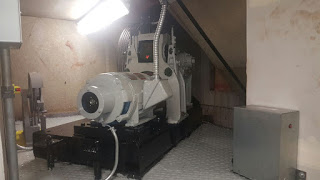In
Chicago we have some very old buildings and aging elevator equipment. When working on a traction modernization we
always take a look at the traction machine and figure out if the machine needs
to be changed. There are several items
you in consideration replacing the machine.
I am by far not an expert on elevator traction machines but here are a
few things I have learned.
Machine wear – This is a very
important item to look at. Is the
existing machine in good condition?
Internal
machine wear
– You need to look at the machine to see if has wear on the gears. Wear or uneven wear is typically indicative
of lack of maintenance, bad installation or high usage. I recently ran into a building that the gears
had to be changed because the OEM had this machine on an “as needed”
maintenance visit, which meant not very often, they ended up having to pull the
gears out to have them replaced because the gear oil was very low.
Sheave
wear
– Most sheaves can be recreated by a machine shop. We have used Titan Machine in New York for
fabricating some sheaves that are out of production and they have done a great
job. There is a point where the cost for
repair/recreation of sheaves exceeds the cost of new machine. Once your drive sheave wears you begin to
wear your cables and your lifespan on each cable typically is cut down by 50%
each recable. Again, if you are not
watching this on maintenance you will have early wear and you will be chasing
your tail to change cables to not wear your sheave more and to change your
sheave not to wear your cables.
Logistics of changing
an existing machine
– 90% of elevator machines are located in a penthouse on top of the
building. This creates a challenge how
to get a new machine into the machine room.
Some machine rooms have scuttle holes, some do not. Some machine rooms have room to hoist, some
do not. One item you have to look at is
how bad in the machine versus the cost to remove a building wall, ceiling,
floor to get a new machine in. We had a
building that required a 3600lb machine to match the drops of the existing
machine. The issue was there was no pick
points and 2 flights of stairs, no easy way to get the new machine up and the
old machine down. We ended up using a
smaller machine with blocking[to get the correct rope drop]. This is not a high traffic or high-speed
elevator so it wasn’t a huge concern about using a smaller sheave. We recently had a building the should have had
the machine replaced but since it was mounted in the attic of a historic
building with slanted roofs we opted to retain the machine and change seals.
Again this elevator was not a high traffic or high-speed elevator so it will
hold up for a long period of time.
[This machine was on a 4' platform and has a slanted 100 year old roof making the replacement difficult, the building opted to keep the machine]
[A new machine going up to replace a 1960's Otis]
[A new machine going up to replace a 1960's Otis]
Future reaction
points
– This is the most important part of the equation. Buildings are built with machine beams for
the elevator that is originally installed.
At times, a new machine has different reactions which will require
larger machine beams or a different layout.
This can create a significant problem if it isn’t paid attention
to. The problem being the structural
integrity of the building. If you are
not knowledgeable of structural support I would recommend having a structural
engineer complete the calculations prior to installation or recommending
replacement.
Accessibility of
parts
– You need to understand if someone can supply, fix or fabricate parts if the
machine needs component parts replaced.
Motors – Most motors can be replaced or
rewound. Some motors are obscure so an
old Montgomery flange mount motor may not be fabricated by a 3rd
party as an AC motor so the machine may need to be replaced if the controller
is modernized.
Gears – There are still some machine shops
out there that can fabricate gears, but at what cost?
Brakes – There are a few elevator brake
providers that can work with any machine.
Again, there are obscure machines that make it nearly impossible to
retrofit a new brake. This is where a
machine shop comes in to repair the old brake.
Speed &
efficiency/Gearless machines – The “gearless” product is becoming very popular. Gearless motors are smaller and can give you
better electrical efficiency and can go faster than a geared machine. Gearless motors also can have a shorter life
than a typical geared traction motor.
The precious metals used for most gearless motors are created in China
and also create a large amount of undesirable waste with their creation.
What
I did not touch on is the cost of replacing a machine during an elevator
modernization which often is the largest driver of if it is replaced or
not. The machine replacement is often
the largest expense of the elevator modernization project.
As
always feel free to contact us at www.colleyelevator.com,
email Craigz@colleyelevator.com or call 630-766-7230.






i'm really thankful to you for this information.
ReplyDeletehospital lift service providers in delhi
glass lift suppliers in delhi